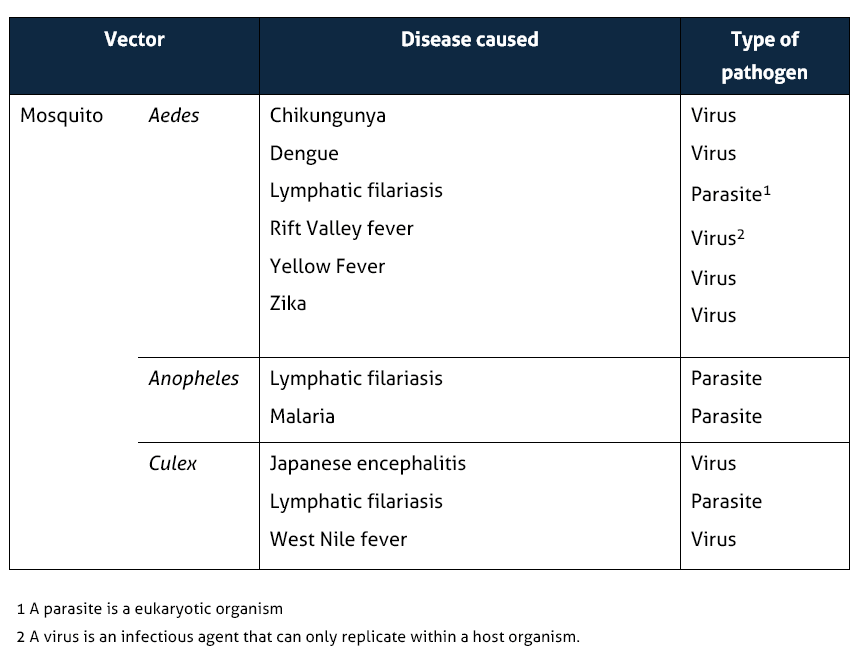Mosquito-borne diseases and their vectors

According to the Centre of Disease Control Prevention (CDC), the mosquito is the deadliest animal and kills more people than any other creature in the world. Mosquito-borne diseases are illnesses transmitted to humans through the bites of infected mosquitoes. These diseases are caused by pathogens (viruses, bacteria or parasites) that mosquitoes carry from one person to another. The most common mosquito-borne diseases include malaria, dengue, zika, chikungunya, and yellow fever. These diseases are transmitted by different types of mosquitoes: malaria is transmitted by Anopheles mosquitoes, while dengue fever, Zika virus, chikungunya, and yellow fever are all transmitted by Aedes mosquitoes.

Mosquitoes are vectors for a number of pathogens that transmit a number of diseases that are called “mosquito-borne diseases”. This is a non-exhaustive list.
Malaria
Malaria is the most well-known mosquito-borne disease, primarily found in tropical countries. It is caused by a parasite that spreads to humans through the bite of an infected female Anopheles mosquito. Malaria spreads when a female Anopheles mosquito bites an infected person and then bites someone else. Malaria may also be spread by transfusion of blood from infected people or by the use of contaminated (dirty) needles or syringes. The malaria parasites enter the second person’s bloodstream and travel to the liver. After maturing, they leave the liver and infect red blood cells. Symptoms can range from milder ones such as fever and headaches to more life-threatening ones like seizures and difficulty breathing. Symptoms usually start 10-15 days after being bitten. The WHO estimated over 200 million cases and 608,000 deaths globally due to malaria in 2023, with the African region continuing to carry a disproportionately high share of the global malaria burden.
Dengue
Dengue is a viral infection transmitted to humans through the bite of an infected mosquito. Dengue is spread by the Aedes mosquito, particularly the Aedes aegypti or Aedes albopictus mosquito. Most people who get dengue will not experience symptoms however, in some cases dengue can be fatal. Symptoms occur 4-10 days after being bitten. These symptoms include high fever, pain behind the eyes, muscle and joint pains and nausea. In 2023, there were over 6.5 million dengue cases, and over 7300 dengue related deaths have been reported from 80 countries according to WHO.
Zika
Zika is a viral infection also transmitted by Aedes mosquitoes. These mosquitoes tend to bite during the day and early evening. According to the WHO, those who get Zika virus do not tend to experience symptoms, however if they do, these include rash, fever, conjunctivitis, muscle and joint pain. Symptoms typically start from 3-14 days after infection. The effects of Zika virus are generally mild but the impact on pregnant women and their babies can be devastating, causing microcephaly.
Chikungunya
Chikungunya is another viral disease transmitted by Aedes mosquitoes. Symptoms of chikungunya typically appear 4-8 days after infection, including the sudden onset of fever, joint pain, headaches, and nausea. Dengue and zika have similar symptoms to chikungunya, making misdiagnosis common. As a result, the number of people affected by this disease is often underestimated. The WHO reports that severe symptoms and deaths from chikungunya are rare and usually occur in individuals with coexisting health issues.
Yellow Fever
Yellow fever is a viral disease transmitted by Aedes and haemagogus mosquitoes. Most people who are infected with this virus do not get sick or only experience mild symptoms. These symptoms include fever, chills, headache, muscle pain. These symptoms tend to arise 3-5 days after they are infected. The CDC finds that 12% of people who have symptoms go on to develop serious illnesses, such as organ failure, jaundice. As of 2023, 34 countries across the African continent and 13 countries in Central and South America are either endemic for, or have regions that are endemic for, yellow fever, reports the WHO.
Mosquito-borne diseases are a massive global burden claiming the lives of many yearly. The World Mosquito Program says that mosquito-borne diseases kill more than one million people and infect up to 700 million each year, almost 1 in 10 people. These diseases contribute to significant mortality, straining healthcare systems and impeding economic development. Continued global efforts in prevention, innovation and education are crucial in reducing the burden and improving global health.
